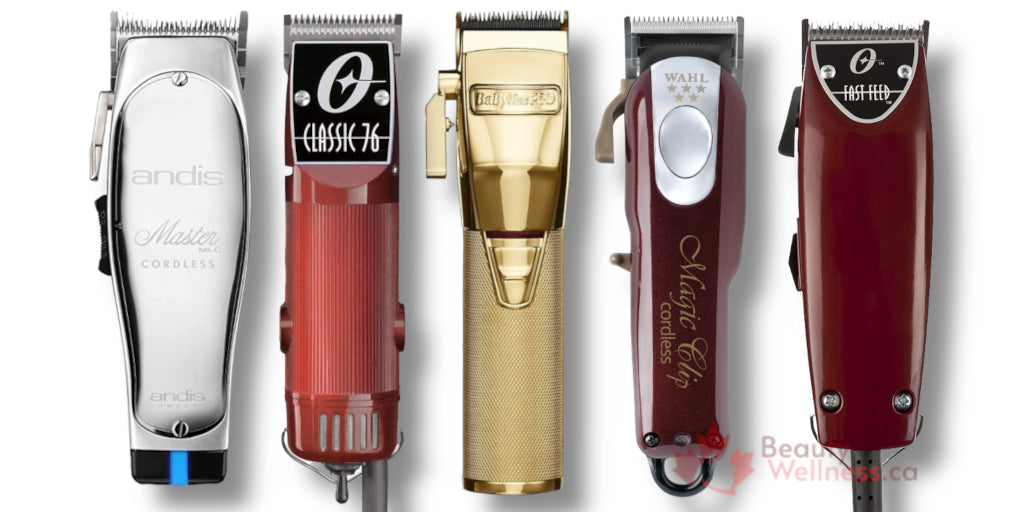Featured Clippers:
- Andis Master Cordless Lithium Ion Adjustable Blade Clipper - 12470
- Oster Classic 76 Clipper - 76076-010 - Universal Motor
- BaBylissPRO GoldFX Clipper | Metal Lithium Hair Clipper - FX870G
- Wahl Professional 5 Star Magic Clip - 56390
- Oster Fast Feed Adjustable Pivot Motor Clipper 76023-510
Taking an appointment and going to the barber's can be time consuming and a headache. To save time and money, you may be thinking about purchasing a clipper for cutting your hair or your family’s hair at home. We know that nothing beats the skills and overall finish of a professional cut and style. That being said, with a little practice, you can achieve a nice clean haircut like a pro. With so many clippers on the market, which is the right one for you?
While there are many choices offering different features, I will go over some of the key points in hopes of making that decision a little more informed. So, let’s get started.
It is most important to consider the type of hair you are cutting and the style you want. Are you cutting coarse, medium, or fine hair? Is the overall density on the head thick, normal or thinning? Are you looking to do a simple all-over buzz cut? Maybe a taper or a tight fade? Or maybe you have multiple family members with different types of hair and you’ll need something that will handle all types of hair and cuts.
Once you have figured out the hair type and style, then you’ll have to consider what clipper is going to give you the best results. Here are some things to consider when selecting a clipper: weight of the machine, motor type, corded or cordless, blades vs guides, and of course, price.
Weight
You must be able to hold the clipper steady for the full job. This sounds simple but is often overlooked. While some people like the feel of a “solid” clipper, when trying to cut your own hair (especially the back of the head), or doing multiple haircuts at once, the weight can begin to play on your grip.
Most clippers have either a metal casing or plastic casing which will affect the overall weight, but this does not affect the performance of the clipper.
Beyond what feels comfortable in the hand, the weight of the unit will be influenced by the clipper’s durability. If you are going to be doing multiple cuts often, then a more durable housing and motor should be what you are looking for; you may have to balance out a heavier unit that’ll last longer. If you are just going to occasionally cut your own hair, then a lighter-weight unit would be advantageous.
Motor Types
There are 3 types when it comes to motors in clippers: the magnetic motor, the pivot motor, and the rotary motor.
The magnetic motor is simple and reliable and consists of a spring and an electromagnet working together to vibrate the cutting blade back and forth. This motor provides high speed but less power, and is sufficient for medium to fine hair, and occasional use. Its simple design and fewer moving parts make it a very durable motor. (i.e. Andis Master Cordless, BabylissPRO PowerFX810, Wahl Senior)
The pivot motor is similar to the magnetic motor except it has no spring. It instead uses two electromagnets. The cutting speed is slower than the magnetic motor, but it has twice the power, making it a better selection for medium to coarse hair and/or for clipping through wet hair. This motor is a good choice for everyday use and is often a favorite amongst hair professionals. It runs cooler and quieter, making it a long-lasting motor. (i.e. BabylissPRO FX870, Oster Fast Feed)
The rotary motor is the workhorse of the clipper family and, whilst maintaining high blade speed, they are the most powerful clippers on the market. They come in AC and DC power units with the latter being cordless and powered by a battery. The cordless units may not contain the same power as their corded brothers but offer freedom of movement away from the wall outlet. These units run cooler than the standard electromagnetic units and won’t become bogged down by thick, coarse hair. These motors are great for thicker hair, heavy-duty cutting, and bulk removal. (i.e. Wahl Magic Clip, Oster Classic 76)
Corded / Cordless
As briefly mentioned above, clippers can come in corded or cordless options. Corded units are usually more powerful but are limited in the distance you can travel from the wall plug. Cordless units give you that freedom to move around, but it comes at the price of a slight drop in power.
Blades vs Guides
Clippers either come with an adjustable blade (i.e. Wahl Magic Clip, BaBylissPRO FX870) or detachable blades (i.e. Oster Classic 76, Oster Titan).
Adjustable blade units will have a lever for the adjustments and come with plastic guides to allow you to cut the hair to the desired length by adjusting the blade settings and guides. Most of these adjustable blade units include 8 Comb Attachments including: #.5 (1/16” - 1.5mm), #1 (1/8"-3mm), #1.5 (3/16"-4.8mm), #2 (1/4"-6mm), #3 (3/8"-10mm), #4 (1/2"-13mm), #5 (5/8"-16mm), #6 (3/4"-19mm).
Detachable blade units are a fixed length of the blade and to alter the desired length of hair, you remove the blade and select the size of the blade required as you’re shaping the hair. These units usually come with an #000 and #1 blade and may include similar plastic guides mentioned above to allow a combination of both blades and guides to achieve the required length/style.
Detachable blade clippers are good for getting a clean, even-length cut; but if you are aiming for a taper or a fade, then an adjustable head with guides may better suit your needs.
Speaking of adjustable heads, they come in two different types of levers for adjustment: the continuous lever and the click style lever. As the name suggests, the continuous lever can be moved freely between the fully closed to fully open position; this allows for tiny micro-adjustments, but also means it is easier to move the lever position on accident (i.e. Wahl Magic Clip). On the other hand, the click style lever clicks into different positions (usually 4-5) between fully closed to fully open; this allows for more consistency with every cut as you can choose the exact position of the lever (i.e. BaBylissPRO FX870).
Price
Although price is a key factor, you have to consider the other points raised above. The lower-priced “barber kits” can feel perfect for the two times a year you give yourself an all-over buzz-cut. That being said, you may find that these units feel cheap and vibrate too much in your hand and you are not getting a clean cut or the fade you wanted to accomplish. Generally speaking, in the clipper world, you get what you pay for. The higher-priced machines are usually sturdier with a more powerful motor and will last longer.
Clippers vs Trimmers… And what about Foil Shavers?
Edging up around the hairline at the end of the cut gives that final finished look. Most clippers can be used to accomplish this feat. An adjustable blade unit, with no guides, used with the gate closed, or a detachable blade machine with a short blade, can be used to clean around the hairline. If you want more precise sharp lines, then a separate trimmer with a smaller blade and tighter cutting area can be used for the hairline and those tight areas around the ears. For shape-ups and making those sharp edges, nothing beats the trimmer. It offers the benefit of being smaller, lighter, and cutting even closer than the clipper. Because of this, trimmers are designed with hypoallergenic blades so they can be used on sensitive skin to avoid skin rashes and irritation. And if you want to go that one step further, the job can be ultimately completed with a foil shaver. The foil shaver cuts the closest of the three machines. They are shaped in a straight line, offering a high level of precision to end the cut with a nice smooth finish.
Some Final Words
Once you consider your hair type, the style(s) you are looking to accomplish, and how often you plan on cutting the hair, select the clipper that best meets your needs and makes you feel comfortable handling your haircuts at home.
We hope this helps in the selection of a clipper you can use to take your look to a whole new level by yourself. Who knows, with a little practice, you might be able to have a few customers of your own!


